Shelf Life
The Host
by Bamboo Dong,

Ouran High School Host Club Season 1 Part 1
Rental Shelf
Freedom Blu-Ray Limited Edition Boxset
Rozen Maiden: Traumend DVD 2
Devil May Cry DVD 3
Perishable
None
Welcome to Shelf Life.
 For the past couple of years, every time I wandered into an anime convention, I would invariably seen an army of girls running around wearing powder blue blazers. I knew it was all part of some Ouran craze, but I never really knew what it was about, or why those cosplayers always happened to be surrounded by a gaggle of screaming women. Now that Funimation has released the first 13 episodes of Ouran High School Host Club, everyone else can be privy to the hoopla.
For the past couple of years, every time I wandered into an anime convention, I would invariably seen an army of girls running around wearing powder blue blazers. I knew it was all part of some Ouran craze, but I never really knew what it was about, or why those cosplayers always happened to be surrounded by a gaggle of screaming women. Now that Funimation has released the first 13 episodes of Ouran High School Host Club, everyone else can be privy to the hoopla.For a series that doesn't have much substance at all, Ouran is surprisingly entertaining, thanks in large part to the characters and their mannerisms. The show starts out when a nerdy kid named Haruhi accidentally wanders into the host club and breaks an expensive vase. To make up for it, the host club members force him to be their errand boy. They eventually realize that he's surprisingly good looking, and transform him into a host, only to realize later that he is a she. There're some love triangles along the way, as most anime tend to have, but it doesn't take over the show and becoming overbearing. And really, the characters are simply fun to watch. As much as the hosts try to please the girls around them, I think they're mostly trying to please the female viewers of the series. There's a level of self-awareness inherent in the show, with lines that make references to how the anime ought to play out, and the best ways to pander to an audience.
On another level, the series also does a good job of poking fun at the upper class. The reason the host club even exists is so that rich boys with too much time on their hands can entertain rich girls with too much time on their hands, so there are some fantastic lines that lampoon the elite's ignorance of the working class. At one point, Haruhi brings the boys a pouch of instant coffee, and watches as they struggle to make sense of it. One of them finally says, “Ahh, poor people don't even have enough free time to grind their own coffee!” It was pretty amazing.
In a show that revolves around indulgences and trivialities, much of the characters' actions succeed in pampering the females who are watching it. Whether it's the twins dressing up as basketball superstars, or pretending to lovesick over one another, it's probably eliciting a billion fangirl squeals a second. As someone who's not really prone to fangirling over anime characters, it still cracks me up to realize just how good the creators are at pandering to their audience. In fact, the entire show is about that, but it does it in such a humorous, self-deprecating way that it's hard to hold it against the series. Overall, it's a delightful show, and I can see why so many girls like it. It's silly, but fun, and I look forward to the continuation.[TOP]
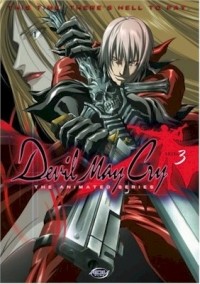 On a slightly less boppy note was the final volume of Devil May Cry, which kind of limps into its grand finale. Up until now (with the exception of the first episode, where an orphan girl named Patty is saved), the episodes have all been standalones. Even the first episode on this disc has a story about a poker player named King who kills everyone he beats in poker. Dante does his best, pumps a couple of bullets, and the matter is resolved accordingly. Like most video-game-to-anime adaptations, things pan out the way you'd expect them to. When there's an enemy, you kill it, and when you need to heal, you sleep or eat.
On a slightly less boppy note was the final volume of Devil May Cry, which kind of limps into its grand finale. Up until now (with the exception of the first episode, where an orphan girl named Patty is saved), the episodes have all been standalones. Even the first episode on this disc has a story about a poker player named King who kills everyone he beats in poker. Dante does his best, pumps a couple of bullets, and the matter is resolved accordingly. Like most video-game-to-anime adaptations, things pan out the way you'd expect them to. When there's an enemy, you kill it, and when you need to heal, you sleep or eat.It's not until the last three episodes that a story arc is established. The basic premise is that there was once a god of devils. As with most extraordinarily powerful beings, he was eventually defeated and sealed away into several fragments, each of which was given to a devil king to protect. Not too surprisingly, there was someone out there who wanted to power of the god, so he pulled some strings, managed to get the kings to kill each other off, so that he could combine the fragments and get all the powers for himself. Yes, this storyline has been done to death, but it's convenient and it works. The only downside is that it's the kind of thing that should take 26 episodes to tell—not three. With only three episodes to work with, it ends up being very rushed and the battles are very anticlimactic. You'd think devils would have some kind of safeguard against regular stabbings, but apparently not.
Luckily, it's easy to go into Devil May Cry with very minimal expectations. For starters, it's a video game adaptation, and they've been notoriously shoddy. As far as this one goes, though, it's actually not that heinous. The series functions well as a stand-alone entity, and honestly, it's not much different from your typical fighter-for-hire show, with the only exception being some familiar characters and the namesake. The animation quality is up to par with a respectable anime, too, so there's really nothing that makes you stop and rethink how much entertainment you're getting out of it. I don't know that fans of the video game would get more enjoyment out of this than non-fans, but it wouldn't hurt. In the end, I wouldn't mind watching this spread over a weekend. Afterwards, maybe I'd be in the mood to mash some buttons.[TOP]
 I was pretty psyched for the next item on my list, for a variety of reasons. It happened to be the limited edition Freedom Blu-Ray box. When I was watching the series the first time, I had been watching some of the discs on HD-DVD, and some of them on standard def, so I was excited for the chance to watch it again entirely in high definition. Plus, this boxset contains “Freedom Seven,” an epilogue to the series which wasn't available the first time through. To sweeten the deal, it also comes with a 28-page original manga, which includes dialogue in English, Japanese, and French. Granted, the short story it tells is kind of extraneous and pointless, but for serious collectors, it's nice to have.
I was pretty psyched for the next item on my list, for a variety of reasons. It happened to be the limited edition Freedom Blu-Ray box. When I was watching the series the first time, I had been watching some of the discs on HD-DVD, and some of them on standard def, so I was excited for the chance to watch it again entirely in high definition. Plus, this boxset contains “Freedom Seven,” an epilogue to the series which wasn't available the first time through. To sweeten the deal, it also comes with a 28-page original manga, which includes dialogue in English, Japanese, and French. Granted, the short story it tells is kind of extraneous and pointless, but for serious collectors, it's nice to have.Freedom is, in some respects, a very well-told, multi-episodic Nissin Cup Noodles commercial. When the characters aren't eating, though, they're part of a story that's almost a call-back to the olden days of anime where man's dream was simply to go to outer space. In Freedom, it's the opposite. The characters have been living on a moon colony all their lives, delaying their ultimate entry into adulthood by racing custom-built vehicles. A dream is ignited when one of them finds a photograph of a young woman standing on a grassy plain with a message on the back that says that Earth is alive and well. Considering they had spent their whole lives learning that Earth was desolate and bare, his curiosity is immediately piqued, and he heads towards Earth on an old shuttle to track down the girl.
For as much as mankind has always loved space, it seems that s far as science fiction is concerned, it's always loved Earth even more. For every story about venturing out into space, there seems to be one about coming home, and Freedom blends the two together. My only beef with this story is that it seems awfully naïve about everything. I understand that humans have a deep yearn for space travel, but it seems ridiculous that you can cobble together a space shuttle out of spare parts and have it land on the moon.
The most important thing to note about this boxset, though, is the inclusion of Freedom Seven. During the HD-DVD/DVD release of the series, only episodes one through six were made available. This was well and good, but the ending just wasn't satisfying at all. The earthlings kept referring to “the Freedom,” and hinted at its ominous nature, but by the end of the last episode, nothing had been resolved. Freedom Seven takes up the story where it left off, showing the two main characters after they've gone back to the moon. It's two years later, and since then, everything and everyone has changed, but now they can learn about the true nature behind their sinister colony, and the reality of Freedom.
Freedom Seven is crucial to the understanding of this series, and it's beyond me why it was never released before this boxset. It doesn't really make the overall story that much better, but it does tie up some loose ends, which is satisfying.
As for the dilemma of purchasing the boxset, consider a few things. This is the first time the series has been released in the US on Blu-Ray, which has the added bonus of being able to condense the whole series onto four discs. I imagine they could've shrunk it even further, but I won't complain. Visually, there is a difference between watching anime in high-def and not. Everything is so much crisper and brighter, and although you really don't need to watch cartoons in high definition, it does add to the experience. Everything in this show is animated with care (even the Cup Noodles), and that extra effort comes through on the Blu-Ray. Another thing to think about is price—buying six episodes of Freedom costs $240 MSRP. This boxset is $140, with places online selling it as low as $100. It's still not cheap considering its only seven episodes, but it's much better than it was the first time around.
Freedom isn't something I plan on watching again after this, but I did enjoy it the two times I saw it. It can be a little slow at times, but the lackadaisical pace in the later episodes does hearken back to an older style of science fiction that I'm fond of. I don't have any intention of buying it, despite its huge price cut, but I am glad I watched it.[TOP]
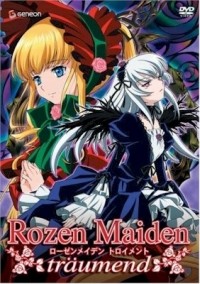 Last on my list this week was the second volume of Rozen Maiden: Träumend, the second season of Rozen Maiden, which was released by Geneon last year. Based on a Peach-Pit manga by the same name, this series is simultaneously hyperactive, somewhat sinister, and a little creepy. The latter is mostly a personal opinion, because dolls scare the sin out of me. Moving dolls are worse.
Last on my list this week was the second volume of Rozen Maiden: Träumend, the second season of Rozen Maiden, which was released by Geneon last year. Based on a Peach-Pit manga by the same name, this series is simultaneously hyperactive, somewhat sinister, and a little creepy. The latter is mostly a personal opinion, because dolls scare the sin out of me. Moving dolls are worse.The protagonist is a boy named Jun, who starts out in the first season as a hikikomori. His life suddenly changes when he enters a contest and a doll materializes in his room. That doll is a Rozen Maiden, a living doll (shudder!) who eventually coaxes him out of his shell. Jun ends up obtaining several of these things over the course of the first season, and they all help him to become more social… despite the ironic reality that he's just sitting around a house talking to dolls.
All of the Rozen Maidens aspire for one thing—to collect each other's souls in order to become “Alice,” so that they can meet their Father, who happened to create them. It's kind of a weird aspiration, and this ends up making the series surprisingly dark. You wouldn't be able to tell this from the first couple of episodes, though—the show is hyperactive to a fault, and it's exhausting watching the girls flit around. Watching one of the youngest dolls riding around on a cat trying to find a postal drop box in the first episode almost broke me, and I had to wait three days before I could continue watching this nonsense. If the show could stick to the storyline about the dolls killing each other and stealing souls, and never having filler ever again, it would be 100x better.
Despite my pure hatred for dolls, it is worth noting the fabulous artwork. Peach-Pit is a really talented group, and all of their works have always been visually outstanding. DearS had some of the cutest girls ever created, and the Rozen Maidens are in that same vein. The costumes are a cosplayer's paradise, too, and although the artwork isn't nearly as nice in the anime as it is in the manga, it still gives the show a good splash of color.
I partially enjoyed the first season, largely for Jun's storyline and his transition out of being a hikikomori, but it will be interesting to see what happens with this Alice storyline. If they keep having bubbly filler, though, I'm liable to punch a hole through my screen. Down with dolls.[TOP]
That's it for this week. Thanks for reading, and check out the pumpkin carving contest we've got going on!

Okay. We've got a killer set of shelves here. I don't think anybody's ready for this jelly, but let's give it a whirl.
This week's shelf obsessees are Conlan and Sharla. They had the following to say about their collection:
I've been a fan of animation for as long as I can remember, but discovered anime in 1996 thanks to Sailor Moon. My wife has been a hardcore anime fan since 1992. We began collecting DVDs in April of 2006 promising each other that we would each only collect our three favourite titles. Our collection now consists of exactly 1570 discs and has almost completely outgrown our bedroom!
The main highlight of our collection is the large number of out of print titles. We keep everything (packaging and discs) in utterly pristine condition. Also, as you can probably tell, we love our shoujo titles and give props to older shows too since our interest in anime is "older than oldschool" by the standards of many fans today.
I wanted to add that the Clover and Panda Kopanda DVDs are official Japanese releases, and the 3-disc Please Save My Earth boxset is an official Korean release.



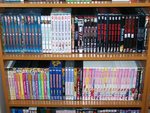
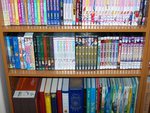
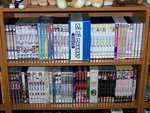





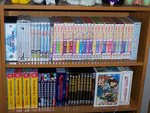
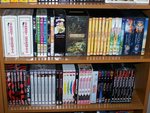



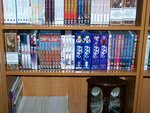


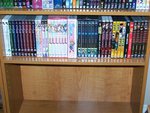




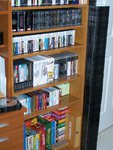



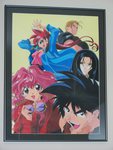

My goodness. How can I befriend you??
Want to show off your shelves? Send your jpgs to shelflife at animenewsnetwork dot com. Thanks!
discuss this in the forum (82 posts) |
this article has been modified since it was originally posted; see change history